From massacres to medals – a story of redemption and recognition
The Napier Waller Art Prize is a unique national prize designed to encourage Australian Defence Force personnel to express their stories and creative talents. Held every second year, in 2024 the prize received its largest number of entries, including one submission by four senior Gija Lawmen and veterans: Mark Nodea and the brothers, Richard, Owen and Peter Thomas. Titled From massacres to medals – a story of redemption and recognition, the painted triptych shares the history of the Gija people’s experience of conflict in the East Kimberly region over the past hundred years. Looking at the panels, the viewer learns of stories passed down the generations from early colonisation to the current day. Using locally sourced materials and traditional practices, the paintings are a poignant expression of truth-telling and healing.
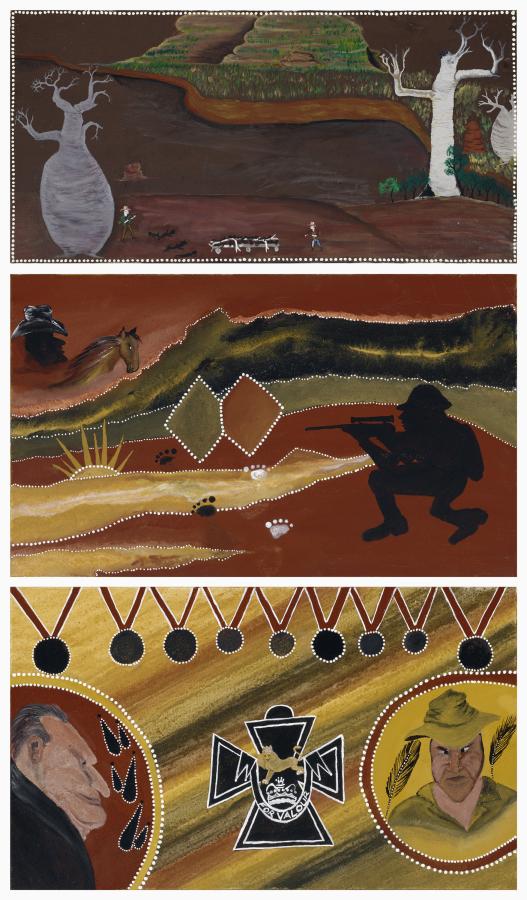
Mark Nodea, Richard Thomas, Owen Thomas and Peter Thomas, From massacres to medals – a story of redemption and recognition, 2023–2024, ochre (sourced locally from Gija Country) on three canvas boards, overall: 180 x 120 cm
The inspiration behind the artwork came to Peter and Owen Thomas during a tour of works from the previous Napier Waller Art Prize while they were visiting the Memorial in 2023. Inspired by seeing work of other veterans, the men returned home to Warmun with the vision of putting their own stories onto canvas. Working collaboratively with Richard Thomas and Mark Nodea, they began interweaving a timeline of historical events and personal experiences.
Panel 1
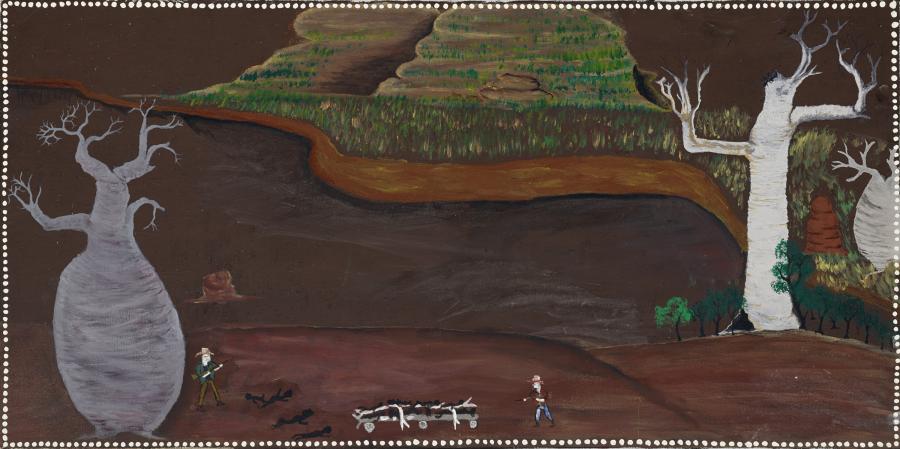
The first painting depicts events in the history of European colonisation in the early 1900s. The beauty of the East Kimberly landscape is shattered by the image of Aboriginal bodies strewn across the foreground. The testimonies of Gija people about these events are part of an oral history passed down through generations. Portraying the massacres committed by Kardiya [white people], the work asserts the veracity of stories of devastating events that took place on Country.
Panel 2
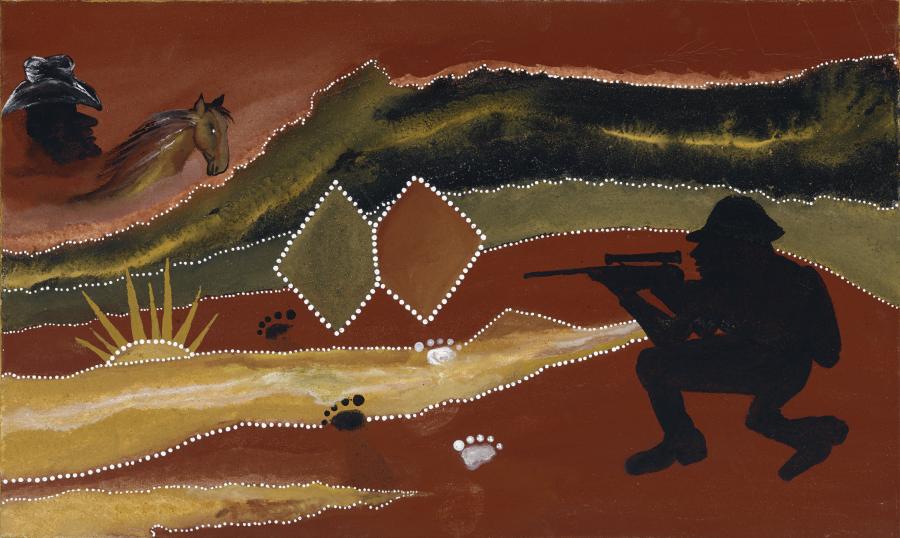
The second painting depicts the legacy of the Australian Army operating in the East Kimberly region. In 1942 the Australian Army raised the 2/1st North Australian Observer Unit, colloquially known as the Nackaroos, to protect the country from invasion. The Army employed 59 local Aboriginal personnel as guides. Despite a history of trauma and injustice, these men generously shared their invaluable local knowledge. A relationship of mutual respect and understanding grew between the Gija people and Army personnel that would live on long after the war was over. The depiction of footsteps and a rising sun, along with rich earth colours, embodies their legacy.
In the early 1990s, the story continued when the Kimberly Squadron established a new patrol in Warmun. Experienced North West Mobile Force (NORFORCE) troop commander Lieutenant (now Major) Mac Jensen was assigned the task of raising the new Warmun Gija patrol. As a former Northern Territory stockman with a knowledge and appreciation for the Gija people, he began by first approaching local Elders to seek permissions and advice. Only the most suitable men for the task were personally handpicked by the Elders, including the artists of this work, who went on proudly to join the Warmun Gija patrol of Kimberly Squadron.
“That Gardiya (army whitefella) showed us how to use machines and goggles and all that thing, but we showed them how to survive in the bush. We gave them our knowledge –traditional knowledge." - Mark Nodea, 2019.
Over the following years Mac Jensen led the all-Gija patrol. With continued permissions and guidance from local Elders, they trained outstanding long-range reconnaissance soldiers for significant border patrol operations. Operating across the East Kimberly region, the patrol also strengthened relationships and left a profound effect on the remote communities they encountered.
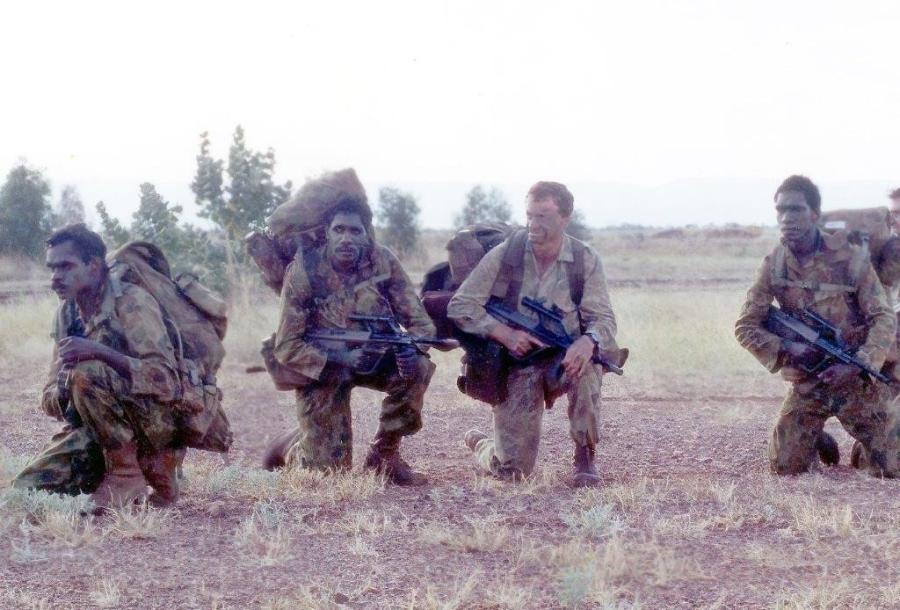
L to R: Private Jimbo Johnson, Private Mark Nodea, Captain Mac Jensen and Private Owen Thomas preparing to board a helicopter for Patrol Insertion, 1994.
Photo: Courtesy of Warmun Arts Centre
Major Jensen invited his friend, Vietnam veteran and Victoria Cross recipient Keith Payne, to assist the Warmun Gija patrol. Greeted warmly, the men began with an exchange of knowledge and respect that would become a close connection and friendship.
“The Gija people helped save this great Australian.” – Gija veterans, 2024.
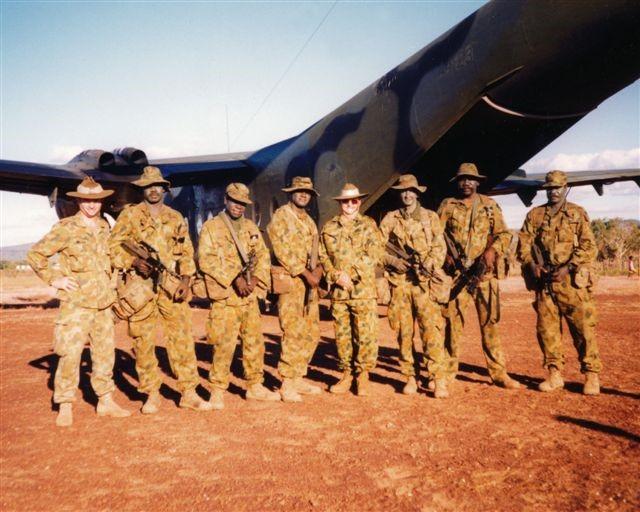
L to R: Major Mac Jensen, Private Basil Clement, Private Ray Wandi, Private John Tipiloura, Keith Payne VC AM, [Unknown], Private Peter Nyalerin and Private Patrick Tataya on OP CANBERRY, Patrol Kalumburu, 2000.
Photo: Courtesy of Warmun Arts Centre
Panel 3
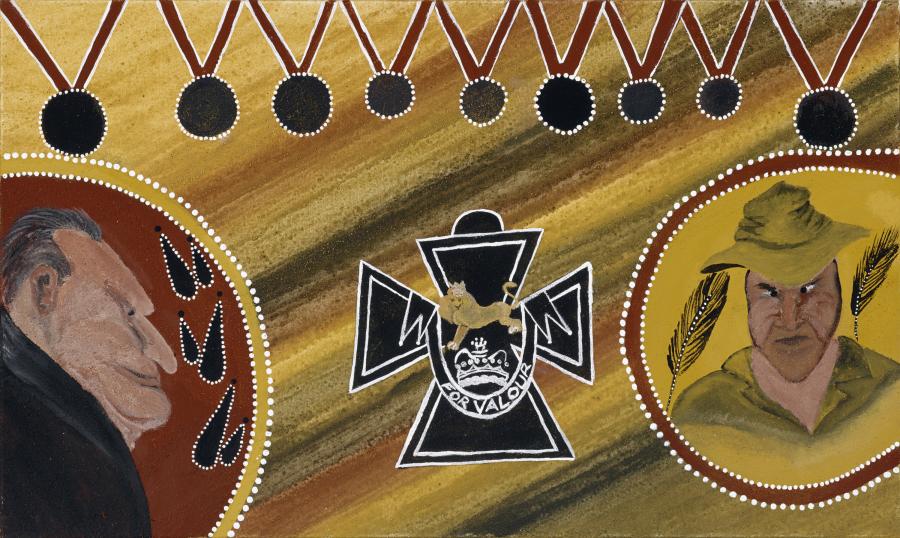
The third painting of the tryptich acknowledges recognition. Years after the Warmun patrol was disbanded, Jensen and Payne began advocating for the recognition of the Warmun patrol’s service. Finally in 2019 a formal award ceremony took place in Warmun community and the nine Gija veterans each received retrospective military service medals – the Australian Defence Force medal and the Australian Operational Service medal. In return the Gija men honoured Major Jensen and Mr Payne through a Joonba ceremony, recognising them as Skin Brothers.
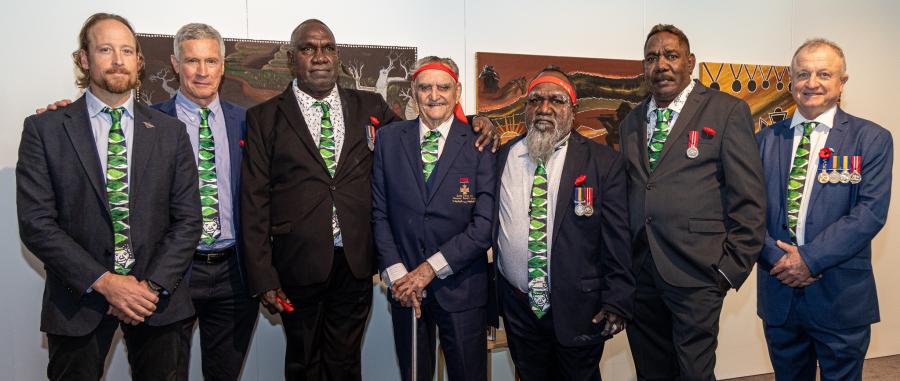
L to R: Chris Dale, David Palmer, Owen Thomas, Keith Payne VC AM, Peter Thomas, Mark Nodea and Major Mac Jensen OAM RFD JP at the opening of the 2024 Napier Waller Art Prize exhibition.
The triptych was selected by the judging panel as a Highly Commended finalist and displayed in the 2024 Napier Waller Art Prize exhibition at Australian Parliament House. At the exhibition launch, the men came together from across the country to reflect on and celebrate their achievements.
Much like the spirit of the Nackaroos, the legacy of the Warmun Gija patrol will continue to live on through stories of valour and pride for future generations.
Linga Linga Yamberremmya
We will remember them
Watch the video below to learn more from the artists as they share the stories and inspiration behind their artwork From Massacres to Medals – a story of redemption and recognition.
The public can view the paintings alongside the other 16 Highly Commended artworks in the 2024 Napier Waller Art Prize exhibition held at Australian Parliament House.
To view all 29 finalists head to the 2024 Napier Waller Art Prize webpage and have your say by voting for your favourite artwork to win the People’s Choice Award. Voting and exhibitions close Sunday 13 October 2024.